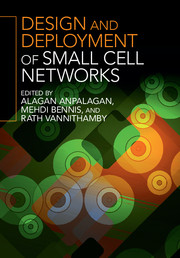Book contents
- Frontmatter
- Contents
- List of contributors
- Preface
- 1 Mobility performance optimization for 3GPP LTE HetNets
- 2 Design and performance analysis of multi-radio small cell networks
- 3 Dynamic TDD small cell management
- 4 3GPP RAN standards for small cells
- 5 Dense networks of small cells
- 6 Traffic offloading scenarios for heterogeneous networks
- 7 Required number of small cell access points in heterogeneous wireless networks
- 8 Small cell deployments: system scenarios, performance, and analysis
- 9 Temporary cognitive small cell networks for rapid and emergency deployments
- 10 Long-term evolution (LTE) and LTE-Advanced activities in small cell networks
- 11 Game theory and learning techniques for self-organization in small cell networks
- 12 Energy efficient strategies with BS sleep mode in green small cell networks
- 13 Mobility management in small cell heterogeneous networks
- 14 The art of deploying small cells: field trial experiments, system design, performance prediction, and deployment feasibility
- 15 Centralized self-optimization of interference management in LTE-A HetNets
- 16 Self-organized ICIC for SCN
- 17 Large-scale deployment and scalability
- 18 Energy efficient heterogeneous networks
- 19 Time- and frequency-domain e-ICIC with single- and multi-flow carrier aggregation in HetNets
- Index
- References
7 - Required number of small cell access points in heterogeneous wireless networks
Published online by Cambridge University Press: 05 December 2015
- Frontmatter
- Contents
- List of contributors
- Preface
- 1 Mobility performance optimization for 3GPP LTE HetNets
- 2 Design and performance analysis of multi-radio small cell networks
- 3 Dynamic TDD small cell management
- 4 3GPP RAN standards for small cells
- 5 Dense networks of small cells
- 6 Traffic offloading scenarios for heterogeneous networks
- 7 Required number of small cell access points in heterogeneous wireless networks
- 8 Small cell deployments: system scenarios, performance, and analysis
- 9 Temporary cognitive small cell networks for rapid and emergency deployments
- 10 Long-term evolution (LTE) and LTE-Advanced activities in small cell networks
- 11 Game theory and learning techniques for self-organization in small cell networks
- 12 Energy efficient strategies with BS sleep mode in green small cell networks
- 13 Mobility management in small cell heterogeneous networks
- 14 The art of deploying small cells: field trial experiments, system design, performance prediction, and deployment feasibility
- 15 Centralized self-optimization of interference management in LTE-A HetNets
- 16 Self-organized ICIC for SCN
- 17 Large-scale deployment and scalability
- 18 Energy efficient heterogeneous networks
- 19 Time- and frequency-domain e-ICIC with single- and multi-flow carrier aggregation in HetNets
- Index
- References
Summary
How many small cell (SC) access points (APs) are required to guarantee a chosen quality of service in a heterogeneous network? In this chapter, we answer this question considering two different network models. The first is the downlink of a finite-area SC network where the locations of APs within the chosen area are uniformly distributed. A key step in obtaining the closed-form expressions is to generalize the well-accepted moment matching approximation for the linear combination of lognormal random variables. For the second model, we focus on a two-layer downlink heterogeneous network with frequency reuse-1 hexagonal macro cells (MCs), and SC APs that are placed at locations that do not meet a chosen quality of service from macro base stations (BSs). An important property of this model is that the SC AP locations are coupled with the MC coverage. Here, simple bounds for the average total interference within an MC makes the formulation possible for the percentage of MC area in outage, as well as the required average number of SCs (per MC) to overcome outage, assuming isolated SCs.
Introduction
Heterogeneous cellular networks (HCNs) are being considered as an efficient way to improve system capacity as well as effectively enhance network coverage [1, 2]. Comprising multiple layers of access points (APs), HCNs encompass a conventional macro cellular network (first layer) overlaid with a diverse set of small cells (SCs) (higher layers). Cell deployment is an important problem in heterogeneous networks, both in terms of the number and positioning of the SCs.
Traditional network models are either impractically simple (such as the Wyner model [3]) or excessively complex (e.g., the general case of random user locations in a hexagonal lattice network [4]) to accurately model SC networks. A useful mathematical model that accounts for the randomness in SC locations and irregularity in the cells uses spatial point processes, such as Poisson point process (PPP), to model the location of SCs in the network [5–10]. The independent placement of SCs from the MC layer, has the advantage of analytical tractability and leads to many useful SINR and/or rate expressions. However, even assuming that wireless providers would deploy SCs to support mobile broadband services, the dominant assumption remains that SCs are deployed randomly and independent of the MC layer [11].
Information
- Type
- Chapter
- Information
- Design and Deployment of Small Cell Networks , pp. 148 - 168Publisher: Cambridge University PressPrint publication year: 2015
